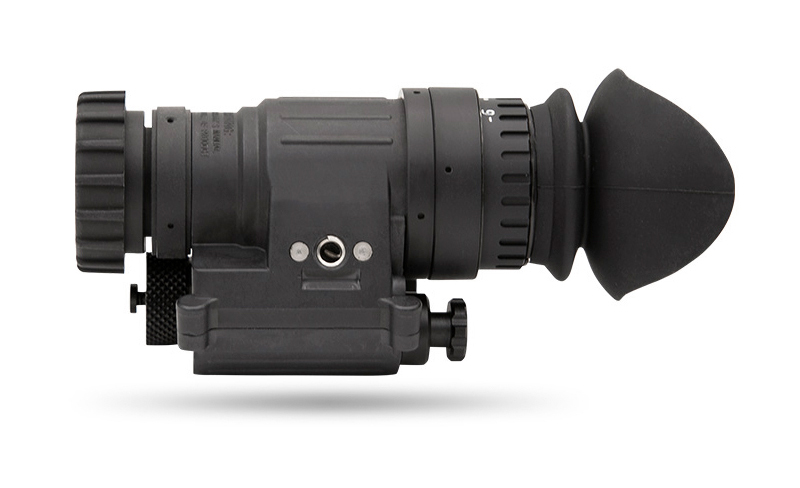December 18, 2024By: MH TECHView: 113

1. Visual experience
Monocular night vision goggles (PVS-14)
Monocular night vision goggles produce monocular visual effects through monocular observation. Just like looking at something with a monocular telescope, it provides a two-dimensional visual experience. The image seen by the user has no sense of depth, and the judgment of distance is relatively more dependent on experience and other auxiliary clues. However, monocular observation in some cases allows the user to maintain a natural perception of the surrounding environment with one eye. For example, when using a monocular night vision goggles to observe a target, the other eye can adapt to changes in ambient light or respond quickly to sudden situations in the surrounding area.
Binocular night vision device (PVS-31)
Binocular night vision device provides binocular vision, which is closer to normal human visual perception. It allows users to see images with a three-dimensional sense, because when observing with both eyes, the brain will calculate the distance and depth of the object based on the difference in the images seen by the left and right eyes. This depth perception ability is very important in scenes such as walking in complex terrain, judging the distance of the target and the spatial relationship. For example, in military operations, soldiers can use binocular night vision devices to more accurately judge the distance of the obstacles in front and the depth of the enemy's position, so as to better make tactical actions.
2. Field of view
Monocular night vision device (PVS-14)
The field of view of monocular night vision devices is usually relatively narrow. Generally speaking, its field of view angle is about 30° - 40°. This means that at the same time, the area that the user can observe through the monocular night vision device is relatively limited. However, this narrow field of view is also beneficial in some cases, such as when the user needs to focus on a specific target or observe in narrow passages, indoor spaces, etc., it can help the user eliminate surrounding interference and observe the target details more concentratedly.
Binocular night vision device (PVS-31)
The field of view of binocular night vision device is relatively wider. Because it is observed by both eyes at the same time, its field of view angle can generally reach about 40° - 60°, and the field of view angle of some high-end models may be wider. A wider field of view allows users to see more of the surrounding environment when observing, such as when patrolling in the field or fighting in open areas, they can find targets from different directions more quickly and enhance situational awareness.
3. Comfort of wearing and use
Monocular night vision device (PVS-14)
Monocular night vision device has a simple structure and light weight, usually around 300 - 500 grams. This makes it lighter to wear and puts less pressure on the head and neck for long-term use. Moreover, the operation of monocular night vision device is relatively simple and easy to use. One hand can adjust the focus, brightness and other operations, and it is more flexible to use. For example, in some scenes that require rapid switching between observation and other actions, such as rapid movement and observation in special operations, the lightness and flexibility of monocular night vision device are very advantageous.
Binocular night vision device (PVS-31)
Due to the two observation channels, the structure of binocular night vision device is relatively complex, and the weight is generally around 500-1000 grams. The heavy weight may cause fatigue of the head and neck after wearing for a long time. However, its design is more ergonomic, and when worn correctly, it can well balance the weight distribution on the head and reduce discomfort. At the same time, the adjustment function of binocular night vision device may be more refined to adapt to the eye spacing and vision differences of different people. Once adjusted, it can provide users with a comfortable observation experience.
4. Price and complexity
Monocular night vision device (PVS-14)
Monocular night vision device has a simple structure and relatively few internal optical and electronic components, so the manufacturing cost is low. This makes it more advantageous in price. The general price is around several thousand yuan to ten thousand yuan, which is more suitable for users with limited budgets, such as the civilian security market, ordinary outdoor enthusiasts, etc. Moreover, its simple structure also means that repair and maintenance are relatively easy, and the probability of failure is relatively low.
Binocular night vision device (PVS-31)
Because binocular observation needs to ensure consistency and comfort, the internal structure of binocular night vision device is complex, and more sophisticated optical systems and electronic components are needed to coordinate the images of the left and right eyes. This leads to a high manufacturing cost, and the price is generally more than 10,000 yuan. High-end military or professional binocular night vision devices may cost more. At the same time, the complex structure also requires more professional knowledge and skills in repair and maintenance, and the probability of failure may be higher than that of monocular night vision devices.
5. Performance
Monocular night vision device (PVS-14)
By adopting advanced image enhancement technology or high-sensitivity detectors, better night vision effects can be achieved. However, since monocular observation may be affected by visual fatigue, after long-term observation, users may experience decreased vision, sore eyes, etc., which will affect the observation effect.
Binocular night vision device (PVS-31)
Binocular night vision devices can use more complex optical design and signal processing technology to optimize image quality. For example, by more finely correcting and fusing the left and right eye images, the clarity, contrast and brightness uniformity of the image can be improved. Moreover, binocular observation can reduce visual fatigue, and the user can maintain a good observation state for a longer period of time, which is more conducive to long-term night missions, such as military reconnaissance and border patrols.